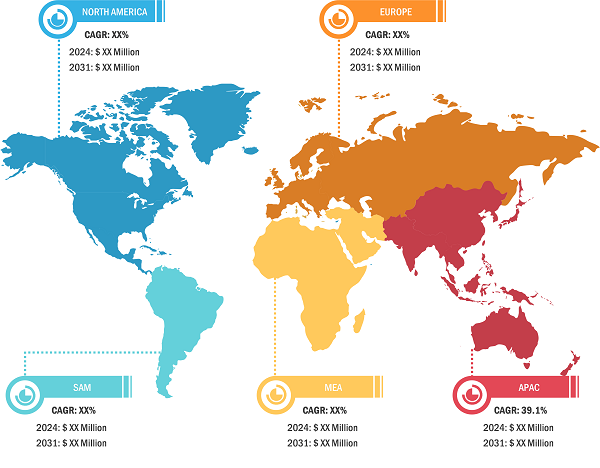Rising Digital Fraud Incidents to Fuel Digital Signature Market Growth During Forecast Period
According to our latest study, “Digital Signature Market Size and Forecast (2021–2031), Global and Regional Share, Trend, and Growth Opportunity Analysis – by Offering, Type, End User, and Geography," the market was valued at US$ 5.45 billion in 2024 and is expected to reach US$ 53.60 billion by 2031; it is estimated to record a CAGR of 38.7% from 2024 to 2031. The report includes growth prospects owing to the current digital signature market trends and their foreseeable impact during the forecast period.
According to the PYMNTS Intelligence report, in 2024, scams surpassed digital payment frauds to become a primary form of fraud. The report also states that scam-related fraud increased by 56% in the US, with financial losses rising by 121%. Scams represented 23% of all fraudulent transactions in the US as of 2024, with trust-based and product/service-related scams being the main contributors to losses. These criminal acts often involve manipulating individuals into authorizing fraudulent transactions through deceptive means. Further, fraud involving compromised credentials, where victims are tricked into disclosing account information, is also on the rise. This shift from digital payment fraud to scams highlights a change in the tactics of fraudsters, who are now exploiting vulnerabilities in human behavior rather than targeting weaknesses in digital payment systems. As scams become more frequent and sophisticated, financial institutions face increasingly complex challenges in managing fraud. According to Signicat’s report, artificial intelligence was associated with 42.5% of fraud attempts detected in the financial sector in 2024. Although deepfakes were not among the top three most prevalent forms of digital identity fraud 3 years ago, now they serve as a prominent means of fraud encountered by companies. The increasing prevalence and sophistication of these forgeries have made them more difficult to detect, driving their rise as a primary tool for identity fraud.
Digital Signature Market Analysis — by Geography
Digital Signature Market Size and Forecast (2021 - 2031), Global and Regional Share, Trend, and Growth Opportunity Analysis Report Coverage: By Offering (Solutions and Services), Type (Advanced Digital Signatures, Qualified Digital Signatures, Basic Digital Signatures, and Simple Digital Signatures), End User (BFSI, Government, Legal, and Others), and Geography
Digital Signature Market Overview and Forecast by 2031
Download Free Sample
Source: The Insight Partners Analysis
As cybercrime and identity theft continue to rise, organizations and individuals are becoming more aware of the need for secure online transactions and communications. According to statistics published by MSB Docs in 2023, global e-signature transactions increased from 198 million to 4,754 million during 2018–2022. Digital signatures, which authenticate the identity of the sender and ensure the integrity of the transmitted data, have become an essential tool in protection against surging fraud incidents. By providing a tamper-proof mechanism for documents and electronic communications, digital signatures help mitigate the risks associated with fraud, data breaches, and unauthorized access. This benefit has led to a surge in the adoption of this type of signature across industries such as banking, healthcare, and legal services, thereby accelerating digital signature market growth.
Zoho Corp Pvt Ltd; PandaDoc, Inc.; DocuSign Inc.; Adobe Inc; GlobalSign, Inc.; Signicat; Signaturit Group; Yousign SAS; Autenti. Sp. z o.o.; Penneo A/S; Oneflow AB (publ); GetAccept Inc.; Skribble AG; and Namirial S.p.A. are among the key players profiled in the digital signature market report. Several other major players were also studied and analyzed during the market study to get a holistic view of the market and its ecosystem.
The report includes the digital signature market forecast based on offering, type, and end user. In terms of offering, the market is bifurcated into solutions and services. The solutions segment held the largest digital signature market share in 2024, and it is expected to record the highest CAGR during the forecast period. The scope of the digital signature market report focuses on North America (US, Canada, and Mexico), Europe (UK, Germany, France, Italy, Netherlands, Sweden, Denmark, Poland, and Rest of Europe), Asia Pacific (South Korea, China, India, Japan, Australia, and Rest of Asia Pacific), the Middle East & Africa (South Africa, Saudi Arabia, the UAE, and Rest of Middle East & Africa), and South & Central America (Brazil, Argentina, and Rest of South & Central America). North America held the largest digital signature market share in 2023, followed by Europe and APAC. In terms of revenue, the UK held the largest share of the market in Europe.
Electronic signatures are legally recognized in the UK, with their use governed by a combination of key regulations. These include the Electronic Identification and Trust Services for Electronic Transactions Regulations (2016), the Electronic Communications Act of 2000 (ECA), and the UK’s retained version of EU Regulation No. 910/2014, known as the eIDAS Regulation, which was amended by the Electronic Identification and Trust Services for Electronic Transactions Regulations 2019 (SI 2019/89) to ensure continued applicability after Brexit. This legal framework establishes the validity and security of electronic signatures in the UK, making them a widely accepted tool for digital transactions. As businesses and organizations increasingly turn to electronic solutions for efficiency and security, the demand for legally compliant and reliable digital signature services is growing in the country. As more sectors, including finance, legal services, and government, adopt electronic signatures to streamline processes and improve security in electronic transactions, the digital signature market in the UK is further expected to continue to grow in the near future.
According to the Office for National Statistics (ONS), in 2023, 44% of the UK workforce was employed remotely, including 16% who worked remotely on a full-time basis and 28% who were classified as hybrid workers, dividing their work time between office and home-based settings. The growing inclination toward remote work contributes to the continued expansion of the digital signature market in the UK.
Contact Us
Phone: +1-646-491-9876
Email Id: sales@theinsightpartners.com